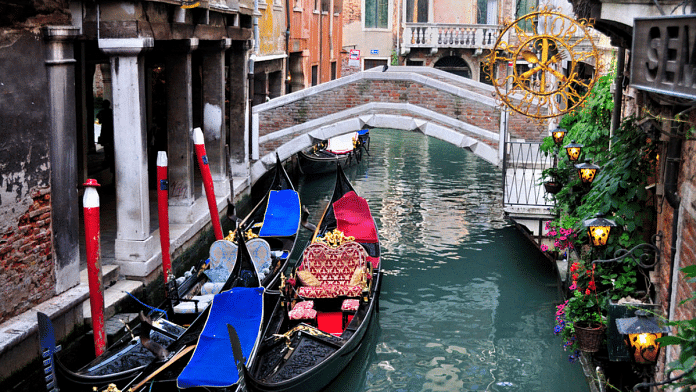Tourist hotspots don’t normally try to reduce visitor numbers, but a growing number are now looking to do so. Why? Because of overtourism and the implications it has for preserving historic sites, air pollution and looking after nature.
Venice is trialling a new tax for day-trippers, which will fluctuate depending on how busy the city is at any given time. At “normal” times, visitors will pay €6 to enter Venice, dropping to €3 during quieter times, and up to a max of €10 when visitor numbers are “overwhelming”.
The city also has an overnight tax in place, the rate of which is based on the number of nights spent and the level or number of stars the accommodation has.
Venice is one of the most visited cities in the world, with millions of people coming to see its sites each year and tourist beds now outnumbering those of residents.
Curbing cruise ships
Meanwhile, Amsterdam has joined Venice as the latest destination to consider restricting tourist levels through bans of cruise ships in its city centres. While the plan has been approved by the city council, the changes have yet to be enacted. Still, the measure is a sign of how cities are balancing tourism and environmental concerns.
“The polluting cruise is not in line with Amsterdam’s sustainable ambitions,” Ilana Rooderkerk of the D66 party, which introduced a motion to close the city’s central cruise ship terminal, told Bloomberg. “Cruise ships in the city centre also do not fit in with the task of combating mass tourism.”

Central Amsterdam is imposing a ban on cruise ships to tackle overtourism. Image: Statista
Amsterdam has one of Europe’s biggest cruise ports, and the city receives more than 1 million tourists in an average month – exceeding its population of 800,000.
On top of this, one big cruise ship can produce the same levels of nitrogen oxide in one day as 30,000 trucks, according to independent research and consultancy business CE Delft.
As more cities and regions try to find ways to curb visitor numbers, this must be balanced with the economic reality that tourism as an industry makes up around 10% of global GDP. One in five new jobs created worldwide in 2014-2019 was in the travel and tourism sector, the World Travel & Tourism Council says.

Travel and Tourism Economic Impact: Tourism generates around 10% of global GDP. Image: World Travel & Tourism Council
When COVID-19 halted global travel, revenues fell 80% for some sub-sectors of the tourism industry in the EU, affecting 11 million jobs.
As tourism bounces back from the pandemic, policymakers are trying to find ways to do it more sustainably – and get tourists to foot some of the bill through ecotourism taxes.
There is an “imperative to embed sustainability and resilience into the design and management of the sector as it rebuilds in the context of the pandemic and increasing geopolitical tensions that are leading to volatility in multiple markets,” the World Economic Forum’s Travel & Tourism Development Index says.
How regions are curbing tourist numbers
The French city of Marseilles last year introduced a reservation system to limit the number of tourists entering the Calanques National Park. It wanted to protect a cove it says is “the most sensitive, vulnerable, and degraded” site in the area.
The system has proven so successful that local authorities have decided to keep it in place for the next four years.
Other destinations are planning campaigns to try to disperse tourists and encourage them to travel to less-visited places. Around 80% of France’s 37 million annual visitors congregate in just 20% of the country.
The balancing act of the ecotourism tax
General tourist taxes have been around for decades at some destinations for a variety of reasons, such as raising funds for infrastructure and facilities.
Specific ecotourism taxes differ as they are ring-fenced payments that will be reinvested in sustainability projects. They can be a way to remind guests of the environmental impact of their visit, Christopher Khoo of tourism consultancy MasterConsult Services told the Eco-Business website.
As Topaz Smith, Community Lead, Aviation, Travel & Tourism at the World Economic Forum, explains, “Ecotourism taxes play a key role in generating revenue to fund sustainable infrastructure development, supporting conservation efforts, promoting environmental education, training hospitality workers, and enhancing local communities’ capacity to manage and benefit from tourism.”
Bali’s fight for water
Bali is the latest Asian destination to say it will introduce an ecotourism tax. It will charge visitors 150,000 rupiah ($10) from 2024.
Freshwater scarcity is a particular concern for Bali. A single tourist uses 1,785 litres of water per day, while locals use around 14 litres, the South China Morning Post reports. And this figure jumps to 4,000 litres a day for tourists staying in hotels.
Like with the introduction of any additional tax, ecotourism taxes will need to strike a balance between the revenue benefits and the potential to deter visitors, according to Zhang Jiajie, Assistant Professor in Human Geography at Singapore’s Nanyang Technological University.
“A robust framework needs to be set up for proper reporting on how the funds raised by such taxes benefit conservation efforts and local livelihoods. Otherwise, the trickle-down effect is questionable,” he told the Eco-Business website.
Gabi Thesing is Senior Writer, Forum Agenda
This article was first published in World Economic Forum. You can read the article here.
Also read: Maharashtra’s Deccan Odyssey luxury train gets whole new look. Carpets, cutlery, colours




